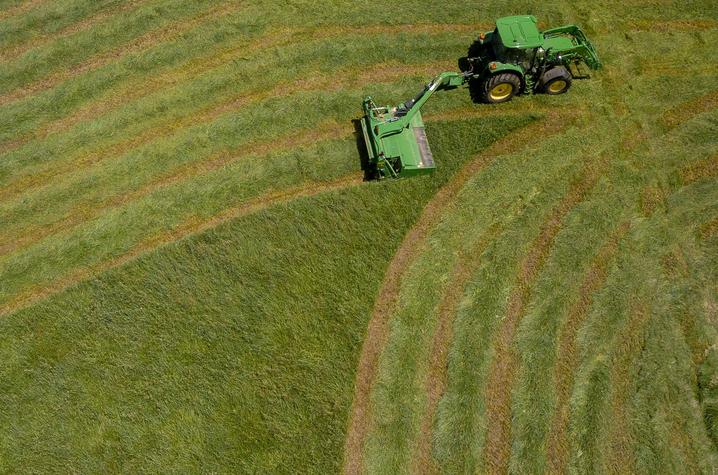Weather extremes force Kentucky producers to rethink hay management, livestock strategy

LEXINGTON, Ky. (Aug. 15, 2024) — Livestock producers across Kentucky are facing challenges of low-quality hay and lower yields this year due to weather extremes. A spring marked by heavy rains, followed by a dry and unyielding summer, has left many producers with a stemmy and possibly rain-damaged first cutting. Along with almost no regrowth due to drought, many producers are now raising concerns about maintaining their livestock through the upcoming winter.
“This year’s weather has been a perfect example of the challenges farmers face,” said UK Department of Plant and Soil Sciences Professor Jimmy Henning, Ph.D. “We went from a very wet spring, which delayed hay cuttings, to an exceptionally dry summer that drastically reduced second cuttings. Too much low-quality hay and little of the higher quality second cutting will put a lot of pressure on our livestock producers.”
Kentucky typically sees its first hay cuttings around late May to early June. However, this year’s weather has disrupted that cycle. The prolonged wet conditions in the spring prevented timely harvests. When the weather finally cleared, the ensuing dry spell left fields barren, with many farmers missing out, or just beginning their second cuttings.
“The second cut looked promising after some rain, but the return of dry conditions halted growth,” said Robert Coleman, Ph.D., UK Department of Animal and Food Science associate professor. “Understanding the available inventory for purchase is tricky, so if you know of hay for sale, it’s wise to secure it now.”
Economic impact and strategic destocking
With the hay market now at a premium, some farmers are feeling the economic pinch. Hay prices have risen, sometimes making it sometimes difficult for producers to purchase additional supplies. To cope, experts are advising farmers to consider strategic destocking, or culling of livestock to manage their resources.
“One of the first steps livestock producers should consider is destocking,” Henning said. “By selling off older or nonproductive animals, farmers can reduce the demand on their hay supplies. It’s a tough decision, but in a year like this, it can be a vital strategy for ensuring the herd’s long-term sustainability.”
Destocking not only helps alleviate immediate pressure on hay supplies but also provides an influx of money that can be used to reinvest in the farm — for purchasing alternative feeds, paying down debt or investing in infrastructure improvements.
Stockpiling and alternative forage options
As producers look for ways to stretch their hay supplies, stockpiling forage — particularly tall fescue — has emerged as a key strategy. Tall fescue, known for its resilience during cooler months, can provide a reliable grazing option in the fall and winter, reducing the need for supplemental hay.
“Tall fescue is an incredible resource for our farmers, especially in the fall and winter months,” Henning said. “Stockpiling fescue allows producers to extend the grazing season and reduce their reliance on hay, which is particularly important in a year when hay supplies are tight.”
Beyond stockpiling, some farmers are exploring using warm-season grasses, such as native species or Bermuda grass, which can thrive during the hot and dry Kentucky summers. While these grasses require a long-term commitment and upfront investment, they also offer a sustainable solution for diversifying forage options and improving pasture resilience.
“Perennial warm-season grasses aren’t a quick fix, but they are a strategic investment for the future,” Henning said. “In years like this, having a diverse pasture system can make the difference between just getting by and truly thriving.”
Reducing hay waste and exploring alternative feeds
Reducing hay waste is an additional critical area where producers can make gains. Traditional methods of feeding hay, such as leaving bales out in the open where they can be trampled and spoiled by livestock, lead to significant losses. Implementing more efficient hay management systems, like ring feeders or covered hay cradles, can drastically reduce waste.
“Hay waste is one of those areas where small changes can make a big difference,” Henning emphasized. “Investing in ring feeders or other efficient hay management systems can significantly reduce the amount of hay that gets trampled and wasted, helping farmers stretch their supplies further.”
While hay management systems can seem like a large initial investment, they save money in the long run.
“A good hay feeder might seem expensive initially, but if it saves you 25% or more of your hay, it quickly pays for itself,” Coleman said. “Especially in years like this, reducing waste can make a huge difference.”
Alternative feeds are becoming an option for those facing severe hay shortages.
“When hay is in short supply, alternative feeds like soybean hulls can be a lifesaver,” Henning said. “These feeds provide the necessary roughage and energy that ruminants need, and while they might not be cheap, they offer a viable option when hay isn’t available.”
As Kentucky farmers navigate these challenging conditions, the importance of long-term planning is becoming increasingly clear. Building resilience into farming operations — whether through diversifying pastures, investing in infrastructure to reduce waste or exploring alternative forages — will be key to weathering future challenges.
As the state’s flagship, land-grant institution, the University of Kentucky exists to advance the Commonwealth. We do that by preparing the next generation of leaders — placing students at the heart of everything we do — and transforming the lives of Kentuckians through education, research and creative work, service and health care. We pride ourselves on being a catalyst for breakthroughs and a force for healing, a place where ingenuity unfolds. It's all made possible by our people — visionaries, disruptors and pioneers — who make up 200 academic programs, a $476.5 million research and development enterprise and a world-class medical center, all on one campus.




